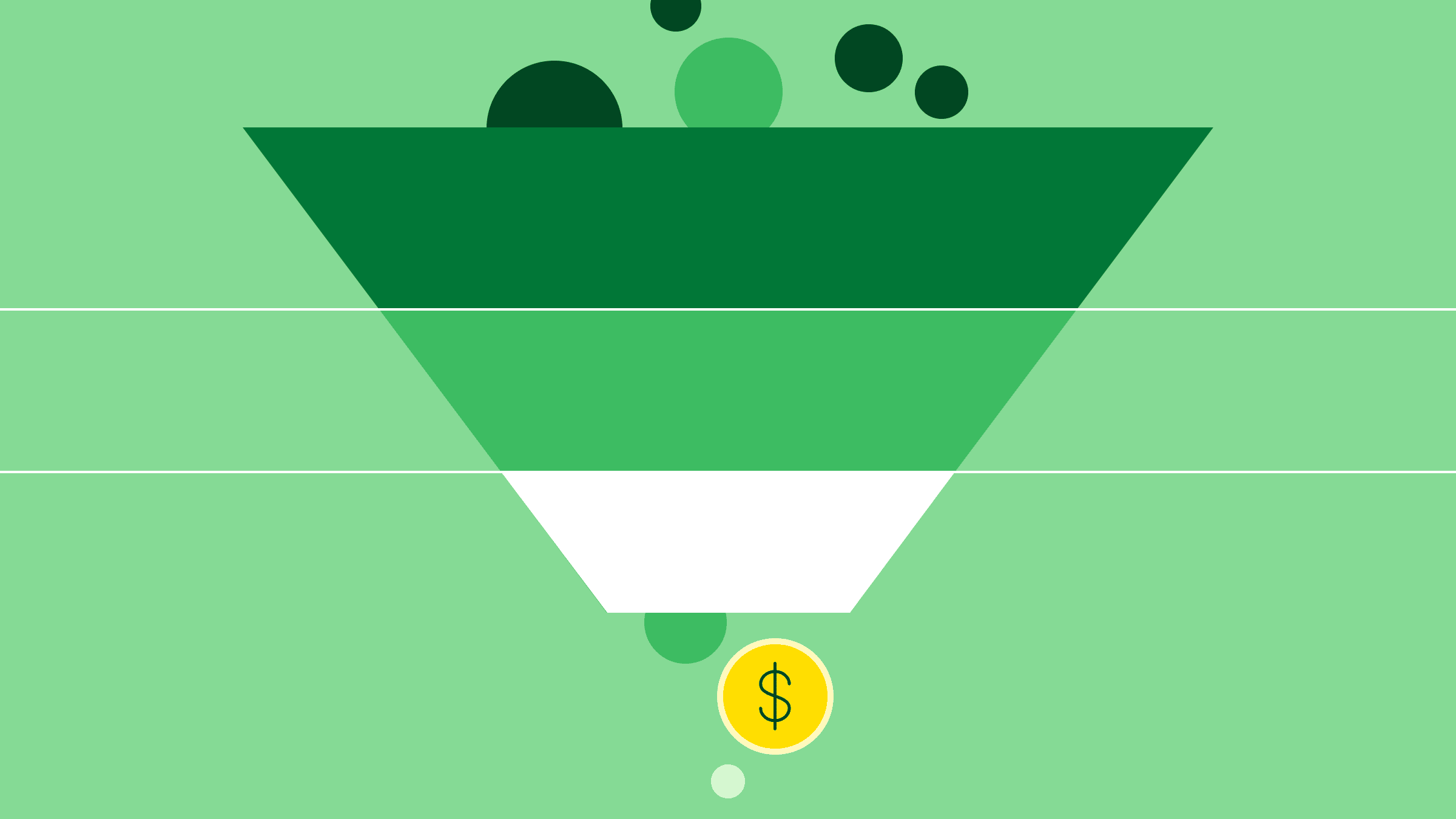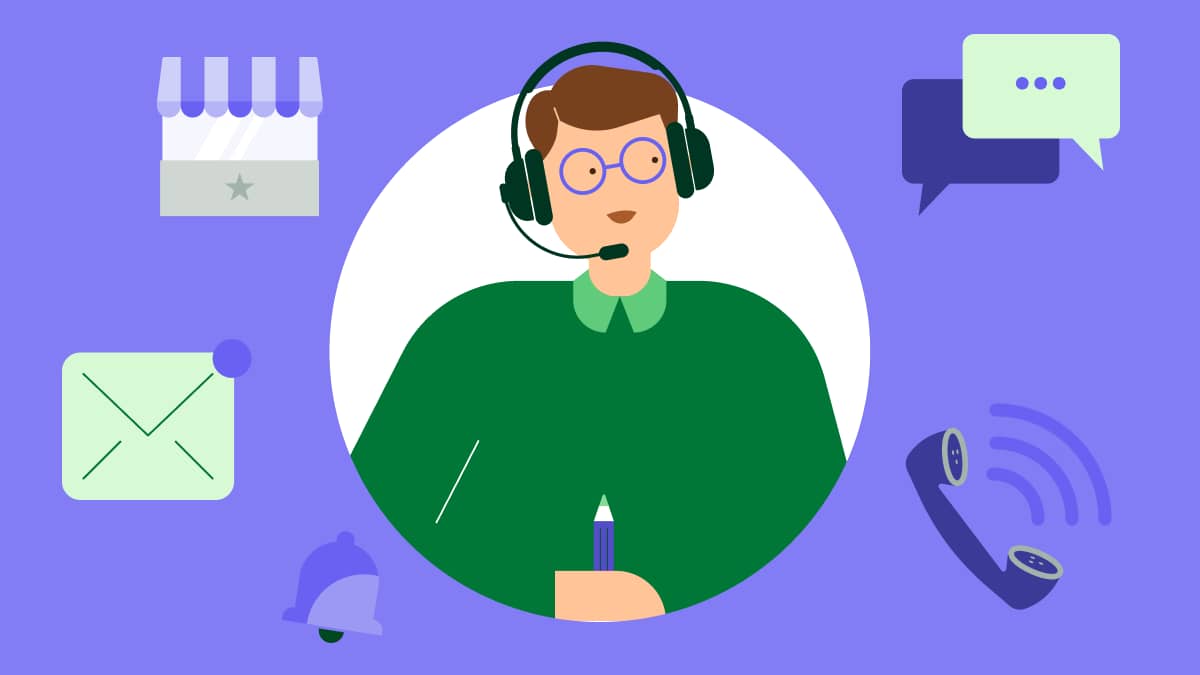Not every customer will continue to do business with your brand. While losing some customers is inevitable, you can reduce the number that churn.
Nurturing customer relationships is a powerful way to prevent churn and create a loyal audience. Understanding why your customers are churning helps you act quickly to repair those relationships and keep them coming back.
In this article, we’ll explain what customer churn means, how to calculate it and why churn is one of the most important metrics to track. We’ll also provide five high-level strategies to minimize your churn rate and satisfy your customers.
What is customer churn?
Customer churn is the percentage of customers that stop doing business with your company within a particular timeframe. The customer churn rate is a measure of the total number of customers lost over a given period of time.
Companies with a subscription model often use churn, as it’s easier to spot when customers leave (e.g., when they cancel their subscriptions).
A high churn rate indicates that your customers are unsatisfied with your products or services. However, churn can occur for many reasons. For example, your customers might prefer a competitor’s new product or simply no longer need your services.
Analyzing why customers churn can help you identify their reasons for leaving and develop better retention strategies.
What is a good churn rate?
Companies should aim for the lowest churn rate possible, although 0% churn is unrealistic.
To decide on a target churn rate for your company, do these two steps:
Compare your current churn rate with the industry average. Knowing the average churn rate for your industry can help gauge your company’s performance against your competitors.
Compare your current churn rate with your past churn rates. Once you have a personal benchmark to work from, you’ll know whether retention is improving over time.
Comparing churn rates against your competitors can be challenging. For starters, churn rates vary between and within industries. Companies don’t like broadcasting their losses and can be closed books, so it’s hard to estimate a realistic average churn rate.
Business insights company Recurly surveyed 1,900 businesses across industries. Here are the average churn rates reported for six popular industries:
SaaS: 4.75%
Digital media and entertainment: 6.42%
Education: 7.22%
Consumer goods and retail: 7.55%
Business and professional services: 6.59%
Healthcare: 6.03%
If your churn rate is significantly higher, say 20–30%, you should find out why (we’ll explain how in just a moment).
Ideally, you set your benchmarks and work to reduce them because a small cut in the churn rate can result in a significant change in revenue. The more customers you have, the larger this effect will be.
How to calculate customer churn rates
To calculate your customer churn rate, you need to choose a particular time frame and then determine the percentage of customers who left your business in that time.
Do this by dividing the number of subscribers lost by the total number of subscribers and multiplying by 100.
To make this a little easier to understand, here’s the formula:
(Number of churned customers at the end of period / Number of customers at the start of period) x 100 = Customer churn rate
For example, say you had 500 customers at the start of the year. By the end of the year, you lost 50 customers.
Your churn rate is:
(50 / 500) x 100 = 10%
Note: Don’t include newly acquired customers when calculating the churn rate as this will throw off your calculations.
Should you use a monthly, quarterly or annual churn rate?
The time frame you use when calculating customer churn rate depends on your sales cycle, products and customers.
Sales cycles are much longer in some industries than others. If your customers go without purchasing from your company for a long time, longer churn rate calculations are more effective. In this case, an annual churn rate may be the way to go.
For each product, you should choose a period that reflects the typical length of your sales cycle. For example, in the B2C SaaS industry, where subscriptions typically renew every month, a monthly or quarterly churn rate would provide the best insight.
Why it’s important to understand and track customer churn
Analyzing customer churn can help you identify why your customers are leaving and find a way to encourage them to stay. For example, you might realize that improving your product will create a better model to outperform a competitor’s more popular product.
After you put new customer retention strategies into place, you’ll be able to track whether they positively affect churn. You’ll then be able to constantly upgrade your sales strategies, reduce the effect of churn on the bottom line and boost profitability.
Here are other reasons why it’s important to understand and track churn:
Lower churn means more revenue. For every customer that churns, you lose potential revenue. Addressing the reasons for churn will help you keep revenue coming in and increase your customer lifetime value – one of the most important sales metrics.
Recurring revenue is vital (especially for SaaS companies). Monthly recurring revenue (MRR) is a business model that relies on repeat customer purchases. Tracking churn tells companies how customer attrition is affecting monthly revenue.
Churned customers can affect your brand’s image. Churned customers might tell other potential customers why they left your company, leading to negative word of mouth, which can affect your image and stop you from acquiring new customers.
Customer acquisition is expensive. Customer acquisition costs (CAC) are often greater than the cost of keeping existing customers – even more so for companies with high churn rates because they must put more resources into gaining new customers.
Churned customers will move to your competitors. If your customers aren’t happy with your products or services, they’ll switch to a competitor that’s doing it better. Therefore, a high churn rate impacts revenue and helps your competitors grow.
What causes customers to churn?
Every company experiences churn. However, if your churn rate is high, these are the most likely reasons:
Slow, unhelpful or inconvenient customer service. Providing excellent customer support is paramount if you want to keep your customers in the long term. A report by PwC found that 32% of customers will stop doing business with a brand after one bad experience.
High competition. Customers will buy the most well-rounded product at the best price point. If you’re experiencing high churn, conduct a market analysis to see what your competitors are doing and how you can improve your brand positioning.
Poor product fit. Customers may churn if your product doesn’t fulfill their needs. Create accurate buyer personas, identify pain points and tweak your products so they address your customers’ unique problems.
Pricing. People are always on the lookout for a cheaper option. If your prices are too high, they might switch brands. In this case, it’s time to reconsider your pricing strategies.
Poor user experience. Customer experience is more important than ever. Buyers are looking for personalized and convenient interactions. If it’s hard for customers to use your website, find information or contact your company, they might move to a competitor.
While these are the main reasons for churn, there are several more and not all are easily avoidable. Below, we’ll explain how you can address each issue with powerful customer retention strategies.
5 strategies to reduce customer churn and retain more customers
If you have a high customer churn rate, it’s time to act. Here are five strategies you can use to reduce customer churn:
1. Analyze your churn to find underlying causes
It’s critical to understand the reasons behind customers leaving so you can proactively prevent them from doing so.
Customer churn predictions help you address attrition before it happens and hold on to more of your valuable customers.
You can conduct a customer churn analysis by investigating buyer sentiment. Here are some tactics to consider:
Use Net Promoter Score (NPS) surveys. NPS surveys ask how likely (on a scale of 1-10) a customer is to recommend your product or brand to a friend. Based on their answer, they’re either a promoter, neutral or detractor (at risk of churning). The aim is to help you set a benchmark as you implement new strategies.
Analyze your support tickets. Support tickets are one of a company's most important sources of insight. If an overwhelming amount of requests are about one topic, address the problem and see if it helps to reduce churn.
Track and respond to online reviews. Pay attention to what people say about your brand online and on social media. You can find opportunities to improve and retain customers by resolving common complaints.
Use open-ended surveys. Providing customers with open-ended customer satisfaction surveys will help you to discover what buyers find frustrating (or satisfying) about the customer experience. It’s crucial to reach out to any lost customers so you can find out what caused them to leave.
2. Use your results to improve the customer experience
Seeking feedback and analyzing the reasons for customer churn is an important part of preventing it. However, acting on customer feedback to improve the customer experience is even more important.
For example, you might find that 65% of complaints are about customer service wait times. Based on this, you could invest in new customer service software that provides self-help tools, like a website AI chatbot. A self-service chatbot can reduce wait times and enable customers to conveniently find the necessary information.
Taking customer feedback seriously will demonstrate you’re committed to improving their experience.
To improve the customer experience further, consider the following strategies:
Use personalized communications. Personalized communication is an effective way to build a customer-centric approach and stay connected with buyers. Collecting and analyzing consumer data will help you better understand their needs and preferences and tailor your communication accordingly.
Simplify the buying process. Streamlining the buying process makes it easier for customers to find what they want. You should have a user-friendly website, clear product descriptions and accurate information. To improve the buying process, test different website design elements for ease of use.
Offer a seamless omnichannel experience. Customers must be able to engage with your company consistently, regardless of platform or device. A unified customer database and synchronized communications ensure your customer journey is consistent regardless of when or how they reach out.
For these strategies to be effective, you need to understand your customers. The best way is to create buyer personas. For each persona, develop effective messaging that resonates.
A good example is when McDonald’s changed from plastic to paper straws in 2018. After a customer-led campaign to reduce plastic straw consumption, McDonald’s cut production of their 1.8 million daily plastic straws in favor of biodegradable paper.
The overarching goal is to make your customers’ experience as streamlined, intuitive and delightful as possible. The better their experience, the more likely they will buy again, recommend your company and stick around.
3. Delight your customers with outstanding support
Customer support can make or break your customer relationships. Things go wrong in business – that’s inevitable. How a company deals with problems and customer complaints can set them above the competition.
Providing customers with accessible, practical and useful support allows you to turn their negative experiences into positive ones.
Here are some things that can take your customer service to the next level:
Provide self-service options. Self-service tools like knowledge bases, FAQs and Chatbots enable your customers to find solutions quickly and easily. You can add these tools to your website and develop them over time, supporting your customers even when your agents are offline.
Give great onboarding and tutorials. The onboarding process is your first and best chance to make a real impression on new customers. Providing in-depth training alongside self-service features like video tutorials allows your customers to get the full benefits from your products.
Make sure customer service is accessible. Customers should be able to contact you quickly – through phone, email or online chat. By providing multiple ways for customers to reach out, you increase your chances of resolving their issues rather than losing them to another company.
Invest in customer success. Customer success is a strategy that proactively helps buyers achieve their goals. The aim is to ensure that customers are engaged and using your product to its fullest potential, reducing the likelihood of a client canceling or switching to a competitor.
Delighting the customer with excellent service is vital because it creates positive customer experiences that can prevent churn. Don’t forget – customer service doesn’t end with the purchase. Providing helpful after-sales service is a great way to keep your customers engaged long after they buy from you.
4. Help customers feel valued by rewarding loyalty
Rewarding customer loyalty can minimize churn by encouraging them to stay faithful to the company.
Gifting customers discounts and special offers can make them feel valued and reduce the likelihood of them switching to a competitor. It can also encourage word-of-mouth marketing, which helps increase your customer base.
Here are some ways to reward customer loyalty:
Follow up with customers after they purchase. After someone completes a purchase, follow up with them to ensure they are satisfied with their overall customer experience. It can be a customer satisfaction survey, an after-sales phone call or a personalized email.
Offer rewards and loyalty programs. Offering rewards can build brand loyalty and create repeat customers. To provide effective rewards, you should segment your customers into groups. Then target each group with an attractive program that keeps customers returning.
Prioritize your most valuable customers. Churn is never good, but when your most loyal customers churn, it can affect your revenue. Giving high-value customers access to special perks like fast-track customer service, priority shipping or exclusive discounts is a great way to encourage them to remain loyal.
Introduce a referral program. Referral programs incentivize customers to refer their friends and family to your company in return for perks such as discounts or vouchers. They are a great way to prevent current customers from churning while increasing customer acquisition at a low cost.
Providing an awesome customer experience, excellent support and personalized marketing material goes a long way toward nurturing customer relationships. However, some clients need an extra incentive to keep them coming back. That’s where loyalty and rewards programs can set you apart.
5. Invest in a powerful CRM solution
Customer relationship management (CRM) solutions provide powerful tools that help understand, track and engage your customers.
Here are five ways CRM software like Pipedrive can help you reduce churn:
Segment your audience and personalize communications. CRM solutions allow you to create detailed customer profiles by segmenting data based on demographics, behaviors, purchase history and more. Segmentation allows you to target different types of customers more effectively with communications that are relevant to their needs.
Automate key tasks. CRM software allows you to automate workflows to improve customer experience. For example, you can set trigger events to happen when a customer performs an action. If a customer signs up on your website, your CRM can automatically send them a welcome letter with a relevant call-to-action (CTA).
Get notifications and reminders. CRM software ensures you never forget a follow-up or meeting. Set up automatic notifications in real time whenever customers interact with your brand.
Track customer service. Keeping track of customer service interactions can help you identify any customer difficulties, enabling you to resolve them before they take their business elsewhere.
Discover hidden insights. Insights and reporting features allow you to dive deep into your customer data and discover insights that would go unnoticed by the human eye.
The above isn’t an exhaustive list of the benefits of CRM software. Companies with a CRM (and the right CRM strategy) have the tools to provide meaningful customer experiences, tailor marketing campaigns and avoid common mistakes that lead to customer churn.
Final thoughts
Unfortunately, not all customers interacting with your brand will become loyal. However, reducing the amount of churn is vital if you want to minimize costs, increase your profit margin and develop a brand image that inspires.
Following the above strategies ensures you stand the best chance of preventing churn and creating a customer base of advocates and evangelists.








